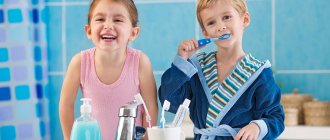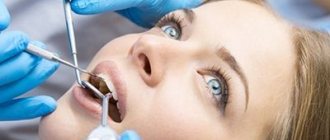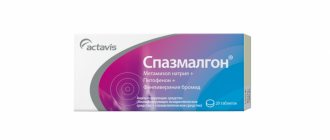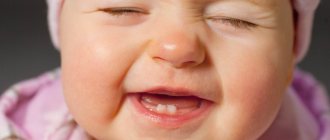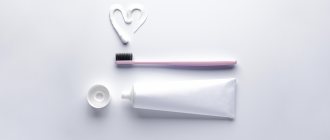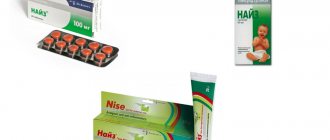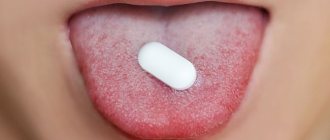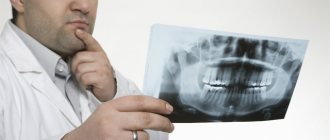What to do if your child has a fever? This question sooner or later arises in every parent who is concerned about the health of their child. But not all mothers and fathers know what temperature can and should be lowered. So, for example, in newborns and babies up to one year old the indicator is up to 37.5-38 degrees, which for us adults is considered elevated, and is the norm. The baby is one month old – does he have a fever? Reduce it only if it rises above 38-38.5.
As for older toddlers, for them this “threshold” is 39-39.5. If the thermometer shows a lower temperature, you should not knock it down. Remember that a child’s fever is an excellent opportunity for the body to fight the infection on its own. Give your baby the opportunity to boost his immunity!
How to reduce a child's temperature?
Now let’s talk about the medications that should definitely be in your first aid kit if a baby is growing up in the family. Thus, pediatricians prohibit the use of drugs such as:
- Aspirin;
- Analgin;
- Nise.
The baby can only be given medications that contain Paracetamol or Ibuprofen. Even if the child has no symptoms, they must be correctly calculated based on the baby’s weight and measured using a special syringe or measuring spoon. You should not use ordinary teaspoons for these purposes, and it is better to completely forget about the concept of “by eye”.
How to reduce a child's temperature?
Doctors advise using only one drug from the above - with Paracetamol or Ibuprofen in the composition. If the temperature drops poorly or does not drop at all, such medications can be alternated. But you can’t give your baby the combined drug Ibuklin.
Please note that it is not at all necessary to reduce the temperature to normal. It is enough just to knock it down a little for the baby’s well-being to improve at least a little. Don’t forget to feed your little one, because in case of high temperature the loss of fluid increases. Pediatricians say that babies need to drink 100 ml of water per 1 kg of weight.
What to do if your baby gets chickenpox?
Has your child caught chickenpox? Of course, this acute viral disease can also cause high fever. How to proceed in this case?
The most important thing is to choose an antipyretic drug for your baby. Under no circumstances should you use Nurofen. To combat high fever during chickenpox, medications containing Paracetamol are suitable.
What to do if your child has a fever?
Does your baby have a fever? Then you can’t hesitate - you need to urgently consult a doctor. Especially if it is accompanied by:
- rash;
- neck muscle tension;
- abdominal pain;
- vomiting.
But don’t panic: fever is typical for most common viral respiratory infections and high temperatures - about 40 degrees. This is how our body responds to infection. The pediatrician will simply examine the child and select the right treatment for him, taking into account the severity of the disease.
Side effects
The risk of side effects can be minimized if you take Nurofen for children in a short course, in the minimum effective dose necessary to eliminate symptoms.
Side effects are predominantly dose-dependent. The following adverse reactions were observed with short-term use of ibuprofen in doses not exceeding 1200 mg/day. When treating chronic conditions and with long-term use, other adverse reactions may occur.
The incidence of adverse reactions was assessed based on the following criteria: very often (≥1/10), often (from ≥1/100 to <1/10), infrequently (from ≥1/1000 to <1/100), rarely ( from ≥1/10,000 to <1/1000), very rare (<1/10,000), frequency unknown (no data available to estimate frequency).
From the hematopoietic system: very rarely - hematopoietic disorders (anemia, leukopenia, aplastic anemia, hemolytic anemia, thrombocytopenia, pancytopenia, agranulocytosis). The first symptoms of such disorders are fever, sore throat, superficial oral ulcers, flu-like symptoms, severe weakness, nosebleeds and subcutaneous hemorrhages, bleeding and bruising of unknown etiology.
From the immune system: infrequently - hypersensitivity reactions (nonspecific allergic reactions and anaphylactic reactions), reactions from the respiratory tract (bronchial asthma, incl.
its exacerbation, bronchospasm, shortness of breath, dyspnea), skin reactions (itching, urticaria, purpura, Quincke's edema, exfoliative and bullous dermatoses, including toxic epidermal necrolysis, Lyell's syndrome, Stevens-Johnson syndrome, erythema multiforme), allergic rhinitis , eosinophilia; very rarely - severe hypersensitivity reactions, incl. swelling of the face, tongue and larynx, shortness of breath, tachycardia, arterial hypotension (anaphylaxis, Quincke's edema or severe anaphylactic shock).
From the gastrointestinal tract: infrequently - abdominal pain, nausea, dyspepsia; rarely - diarrhea, flatulence, constipation, vomiting; very rarely - peptic ulcer, perforation or gastrointestinal bleeding, melena, hematemesis, ulcerative stomatitis, gastritis; frequency unknown - exacerbation of ulcerative colitis and Crohn's disease.
From the liver and biliary tract: very rarely - liver dysfunction.
From the urinary system: very rarely - acute renal failure (compensated and decompensated), especially with long-term use, in combination with an increase in the concentration of urea in the blood plasma and the appearance of edema, papillary necrosis.
From the nervous system: infrequently - headache; very rarely - aseptic meningitis (in patients with autoimmune diseases).
From the cardiovascular system: frequency unknown - heart failure, peripheral edema, with long-term use there is an increased risk of thrombotic complications (for example, myocardial infarction, stroke), increased blood pressure.
From the respiratory system: frequency unknown - bronchial asthma, bronchospasm, shortness of breath.
Other: very rarely - swelling, incl. peripheral.
Laboratory parameters: hematocrit or hemoglobin may decrease, bleeding time may increase, plasma glucose concentration may decrease, QC may decrease; plasma creatinine concentration may increase; hepatic transaminase activity may increase.
If side effects occur, you should stop taking the drug and consult a doctor.
What temperature should be lowered in a child with influenza and ARVI?
High temperature forces the child's body to turn on its protective function. In this case, there may be a general deterioration in the form of malaise and headaches. The child becomes lethargic and whiny, which brings a lot of anxiety to parents. Before bringing down a child’s high temperature, you need to clarify significant nuances.
A slight increase in temperature does not lead to serious consequences and does not require any measures to be taken. Parents need to have reliable information about what temperature should be lowered. Improper actions can cause weakened immunity. There is a risk of developing possible complications and the disease may become protracted.
Cases when you need to bring down the temperature in children:
- 37.2-37.9°C (low-grade fever) – should be taken for newborns up to 2 months of age if indicated;
- 38.0-38.9°C (febrile) – antipyretics must be given in all cases;
- over 41.0°C (hyperthermic) - you need to call an ambulance if the drugs do not lower the readings on the thermometer.
It is necessary to call an ambulance if febrile spasms appear - this is intolerance to high temperature, an individual feature of the child’s body. This condition usually does not occur in children over 6 years of age (provided there are no pathologies in the central nervous system).
Chronic or acute diseases in cardiology, neurology or lung disease require lowering the temperature in children if the readings are above 38°C. Otherwise, complications from the heart, nervous system and respiratory organs cannot be ruled out.
If you have difficulty lowering your temperature, you should immediately seek medical help. If the thermometer has barely reached 37°C, and the child looks lethargic and his health is only getting worse, you should not expect a further increase in the readings on the thermometer.
When and in what order do baby teeth emerge?
For most children, the teething pattern looks like this:
- At 6-8 months, two central lower incisors appear.
- At 8-9 months, the upper central incisors.
- At 9-12 months, the upper lateral incisors erupt.
- At 11-12 months, the lower lateral incisors.
- At 12-15 months, the upper and lower molars.
- At 16-18 months, the upper canines
- At 18-20 months, the lower canines.
- Chewing teeth erupt at 2-3 years of age.
During normal development, baby teeth erupt in each area within 2-10 days, and the most unpleasant symptoms usually appear within 2-5 days. All 20 baby teeth erupt by age 3.
What to do if teeth are cut chaotically and behind schedule?
There is no need to sound the alarm right away. In some children, teething begins at 3 months, and in some at 10, and this is not a pathology, but a feature of the body. The same applies to the violation of the order of appearance of the incisors.
But if there is a delay of 3-5 months, you need to go for a consultation with a pediatrician or dentist.
How to properly lower the temperature at home?
Effective folk ways to reduce fever without medications in children:
- A drink made from cranberries is a unique diaphoretic that reduces fever. The berry is useful for containing vitamins and accelerates the elimination of decay products.
- Chamomile tea is an excellent anti-inflammatory remedy. To prepare the infusion, pour a tablespoon of chamomile into a glass of boiling water, let it brew for 2 hours, drink up to 5 times a day.
- Elderberry decoction effectively helps reduce fever. It is enough to take 50 g of elderberry and pour boiling water (200 ml) over it.
- Linden tea – gives excellent results when consumed with honey. The child will sweat profusely, which will reduce body temperature due to the evaporation of excess moisture from the skin.
You can wipe the child's body with a terry towel moistened with water at room temperature. Applying a heating pad with ice to large vessels helps. Wrapping in a damp towel or sheet is also recommended.
Medications
Before lowering your child’s temperature at home with medications, you must carefully study the instructions for use. Classic drugs can be bought in pharmacies, choose the dosage and form that is needed and choose the best option depending on age and indications.
The baby can only be given medications that contain paracetamol or ibuprofen. Paracetamol is contained in Panadol and Cefekon, ibuprofen is found in Nurofen and Ibufen. For babies, these products are available in the form of syrup, which, unlike tablets, has a sweet taste and is more convenient to dose.
Standard antipyretic drugs:
- "Panadol". Suitable for use on infants. The drug is indicated for colds, teething, otitis media, whooping cough and other infections. Prescribed to children aged 3 months and older in an individual dosage.
- "Efferalgan." Used as an analgesic and antipyretic. Rectal suppositories can be used to relieve fever in infants 3 months and older. Unlike medications taken orally, it does not cause vomiting and does not affect the gastrointestinal tract.
- "Ibufen." Has analgesic and antipyretic properties. In childhood, this drug is used in a dosage calculated depending on the weight and age of the child.
- "Paracetamol". An effective antipyretic and analgesic. It can be alternated with ibuprofen. If there is vomiting, you can use suppositories (suppositories).
- "Cefekon D". Available in the form of suppositories, recommended for use from 3 months to 12 years. Important advantages of the drug are its low cost and versatility. In addition to reducing temperature, it has an anti-inflammatory and analgesic effect.
A child's body can react to different medications differently, so you should experiment in practice to determine a more effective remedy, based on the pediatrician's recommendations.
When taking medications, you should follow a number of rules:
1. You cannot give several medications at the same time.
2. Drugs can be alternated, but the interval between taking medications should be 2-3 hours.
3. It is recommended to dose syrups using a measuring spoon or syringe, which are included in the kit.
4. If a child 1 year or younger is sick, it is recommended to use suppositories. Older children take tablets and capsules easily. Without a doctor's recommendation, antipyretic drugs can be prescribed to children for no longer than 3 days in a row and no more than 4 times a day.
5. Parents must understand that high body temperature is just a symptom indicating a specific disease. Taking antipyretics is not a treatment; it is only necessary to alleviate the child’s condition before the doctor arrives.
Interaction with other drugs
The simultaneous use of Nurofen for children with the drugs listed below should be avoided.
Acetylsalicylic acid: with the exception of acetylsalicylic acid in low doses (no more than 75 mg/day) prescribed by a doctor, since combined use may increase the risk of side effects.
With simultaneous use, ibuprofen reduces the anti-inflammatory and antiplatelet effect of acetylsalicylic acid (an increase in the incidence of acute coronary insufficiency in patients receiving acetylsalicylic acid in small doses as an antiplatelet agent is possible after starting ibuprofen).
Other NSAIDs, including selective COX-2 inhibitors: The simultaneous use of two or more drugs from the NSAID group should be avoided due to a possible increased risk of side effects.
Use with caution concomitantly with the following medications.
Anticoagulants and thrombolytic drugs: NSAIDs may enhance the effect of anticoagulants, in particular warfarin and thrombolytic drugs.
Antihypertensive drugs (ACE inhibitors and angiotensin II receptor antagonists) and diuretics: NSAIDs may reduce the effectiveness of drugs in these groups. Diuretics and ACE inhibitors may increase the nephrotoxicity of NSAIDs.
GCS: increased risk of gastrointestinal ulcers and gastrointestinal bleeding.
Antiplatelet agents and selective serotonin reuptake inhibitors: increased risk of gastrointestinal bleeding.
Cardiac glycosides: simultaneous administration of NSAIDs and cardiac glycosides can lead to worsening heart failure, a decrease in glomerular filtration rate and an increase in the concentration of cardiac glycosides in the blood plasma.
Lithium preparations: there is evidence of the likelihood of an increase in the concentration of lithium in the blood plasma during the use of NSAIDs.
Methotrexate: there is evidence of the likelihood of an increase in the concentration of methotrexate in the blood plasma during the use of NSAIDs.
Cyclosporine: increased risk of nephrotoxicity when NSAIDs are administered concomitantly with cyclosporine.
Mifepristone: NSAIDs should be started no earlier than 8 to 12 days after taking mifepristone, as NSAIDs may reduce the effectiveness of mifepristone.
Tacrolimus: When NSAIDs and tacrolimus are coadministered, the risk of nephrotoxicity may increase.
Zidovudine: Concomitant use of NSAIDs and zidovudine may result in increased hematotoxicity. There is evidence of an increased risk of hemarthrosis and hematomas in HIV-positive patients with hemophilia who received concomitant treatment with zidovudine and ibuprofen.
Quinolone antibiotics: In patients receiving concomitant treatment with NSAIDs and quinolone antibiotics, the risk of seizures may be increased.
What should you not give to children?
Reducing a child’s temperature is not difficult - today there are many drugs on sale that relieve fever in a short time. But first you need to consult with a qualified pediatrician, because self-medication can affect the baby's health.
If the readings do not exceed 38.5°C, there is no need to lower the temperature, because The body independently produces antibodies that help destroy viruses - so to speak, it fights the infection.
Medicines that are not recommended for children:
- amidopyrine, antipyrine and phenacetin (many side effects);
- acetylsalicylic acid (reduce the number of platelets, causing bleeding, allergic reactions, etc.);
- analgin and other drugs containing metamizole sodium as an active substance (side effects occur, such as suppression of hematopoiesis, severe allergic reactions, etc.).
These drugs are not recommended for use without the advice of a doctor. When you need to bring down the temperature, give preference to another medicine.
Contraindications
Contraindications to the use of Nurofen suspension for children are: complete or incomplete combination of bronchial asthma, recurrent polyposis of the nose and paranasal sinuses and intolerance to acetylsalicylic acid or other NSAIDs; a history of bleeding or perforation of a gastrointestinal ulcer caused by the use of NSAIDs; erosive and ulcerative diseases of the gastrointestinal tract (incl.
peptic ulcer of the stomach and duodenum, Crohn's disease, ulcerative colitis) or ulcerative bleeding in the active phase or in history (two or more confirmed episodes of peptic ulcer or ulcerative bleeding); severe liver failure or active liver disease; severe renal failure (creatinine clearance <30 ml/min); confirmed hyperkalemia; decompensated heart failure; period after coronary artery bypass surgery; cerebrovascular or other bleeding; hemophilia and other bleeding disorders (including hypocoagulation); hemorrhagic diathesis; III trimester of pregnancy; fructose intolerance; child’s body weight up to 5 kg; hypersensitivity to ibuprofen or any of the components included in the drug.
The drug should be prescribed with caution when using other NSAIDs simultaneously; a history of a single episode of gastric ulcer or ulcerative bleeding of the gastrointestinal tract, gastritis, enteritis, colitis, the presence of Helicobacter pylori infection, ulcerative colitis; bronchial asthma or allergic diseases in the acute stage or in history (possible development of bronchospasm); severe somatic diseases; systemic lupus erythematosus or mixed connective tissue disease (Sharpe's syndrome) - increased risk of aseptic meningitis; renal failure, incl.
with dehydration (creatinine clearance 30-60 ml/min), fluid retention and edema; liver failure; arterial hypertension and/or heart failure; cerebrovascular diseases; dyslipidemia/hyperlipidemia; diabetes mellitus; peripheral arterial diseases; blood diseases of unknown etiology (leukopenia, anemia); simultaneous use of other drugs that may increase the risk of ulcers or bleeding, in particular, corticosteroids for oral administration (including prednisolone), anticoagulants (including warfarin), selective serotonin reuptake inhibitors (including including citalopram, fluoxetine, paroxetine, sertraline) or antiplatelet agents (including acetylsalicylic acid, clopidogrel); in the 1st and 2nd trimester of pregnancy, during breastfeeding, in elderly patients.
Is it necessary to bring down a child’s temperature to 36.6?
If, after using antipyretics, the readings decrease by 0.5°C within an hour, then the process is normal. Do not aim to reach 36.6°C immediately. This can cause serious overload of the child’s body, which can lead to a deterioration in overall well-being.
The ideal temperature would be 37-37.5 degrees. After some time, a jump may occur again. This occurs because the active component of the medicine is excreted from the body and ceases its effect. If several hours have passed after taking the drug, you can give the child another dose. It is very important to observe time intervals between doses and monitor temperature readings.
With an effective fight of the immune system against pathogenic microbes and with a competent approach to treatment, recovery, as a rule, is 3-5 days.
Overdose
In children, overdose symptoms may occur after taking a dose exceeding 400 mg/kg body weight.
In adults, the dose-dependent effect of overdose is less pronounced. T1/2 of the drug in case of overdose is 1.5-3 hours.
Symptoms: nausea, vomiting, epigastric pain or, less commonly, diarrhea, tinnitus, headache and gastrointestinal bleeding. In more severe cases, manifestations from the central nervous system are observed: drowsiness, rarely - agitation, convulsions, disorientation, coma. In cases of severe poisoning, metabolic acidosis and an increase in prothrombin time, renal failure, liver tissue damage, decreased blood pressure, respiratory depression and cyanosis may develop. In patients with bronchial asthma, exacerbation of this disease is possible.
Treatment: symptomatic, with mandatory maintenance of airway patency, monitoring of ECG and vital signs until the patient’s condition is normalized. Oral use of activated charcoal or gastric lavage is recommended within 1 hour after taking a potentially toxic dose of ibuprofen. If ibuprofen has already been absorbed, an alkaline drink may be prescribed in order to eliminate the acidic derivative of ibuprofen by the kidneys, forced diuresis. Frequent or prolonged seizures should be treated with IV diazepam or lorazepam. When bronchial asthma worsens, the use of bronchodilators is recommended.
How to help a child’s body fight infection?
Regardless of whether you follow the recommendations on what temperature to lower in children, you must take care to create the necessary conditions for the patient. All family members should improve the quality of personal hygiene: wash their hands, wear disposable gauze bandages, etc. You also need to provide the child with separate cutlery and dishes.
Recommendations for a speedy recovery:
1. A sick child must remain in bed.
2. It is necessary to ventilate the room in which the baby is located (the influenza virus and other microorganisms are concentrated in musty air).
3. Care should be taken to humidify the air (at the same time, the mucous membranes of the nose and larynx do not dry out; this improves local immunity and promotes well-being).
4. You should ensure that you drink plenty of fluids (virus breakdown products are eliminated through the kidneys, which reduces the load on the body).
5. The baby’s clothes should be light, preferably made from natural fabrics.
6. It is considered normal for a baby to have no appetite. You should avoid spices, citrus fruits, and dairy products, which can cause irritation of the gastric mucosa. A hot bath at a high temperature is not the most pleasant feeling, but cool (not cold) water can help normalize the indicators.
7. It is recommended to use the bath together with antipyretics, and not instead of them. You can also get some relief by applying a cool compress to your forehead.



